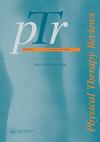痉挛的评估:系统综述
IF 0.8
Q4 REHABILITATION
引用次数: 2
摘要
背景痉挛是上运动神经元损伤后常见的损害。由于痉挛是一种难以评估的复杂现象,因此提出了许多关于痉挛的定义。解决痉挛的测量和改善与痉挛评估相关的临床实践是很重要的。有许多与痉挛评估相关的系统综述,其质量、框架和方法各不相同。目的:我们旨在系统地评价已发表的系统综述中与各种神经系统疾病患者痉挛评估相关的证据。方法在PubMed、CINAHL、Embase、Cochrane Library等数据库中进行文献检索。两名独立审稿人筛选文献检索结果以纳入相关研究。随后,审稿人使用标准化表单提取数据。研究质量采用多系统评价评估(AMSTAR)进行评估,证据质量采用推荐、评估、发展和评价等级(GRADE)进行严格评价。结果经过文献检索和筛选,本系统综述共纳入19项研究。在这19项研究中,发现了60种不同的痉挛评估工具。临床痉挛指标33项,生物力学指标18项,神经生理学指标8项。大多数系统评价的AMSTAR评分为低至中等,证据水平(GRADE)普遍较低。总的来说,我们的研究结果表明,尽管几十年的研究,痉挛评估仍需要进一步的研究。大多数与痉挛评估相关的证据都很低,大多数研究依赖于评估被动运动阻力而不是痉挛的方法。未来的研究非常有必要阐明评估痉挛的正确方法。本文章由计算机程序翻译,如有差异,请以英文原文为准。
Assessment of spasticity: an overview of systematic reviews
Abstract Background Spasticity is a common impairment following an upper motor neuron lesion. A number of definitions were proposed for spasticity, as it is a complex phenomenon that is difficult to assess. It is important to address the measurement of spasticity and improve clinical practices related to assessing spasticity. There are numerous systematic reviews related to spasticity assessment varying in their quality, framework and methodology. Objective We aimed to systematically evaluate the evidence from published systematic reviews related to assessment of spasticity in people with various neurological conditions. Methods A comprehensive literature search was conducted in the following databases: PubMed, CINAHL, Embase and The Cochrane Library. Two independent reviewers screened the literature search results to include relevant studies. Subsequently, reviewers extracted the data using a standardized form. The quality of studies was assessed using Assessment of Multiple Systematic Reviews (AMSTAR), and the quality of evidence was critically appraised with Grades of Recommendation, Assessment, Development and Evaluation (GRADE). Results Following the literature search and screening process, a total of 19 studies were included in this overview of systematic reviews. Within these 19 studies, 60 different spasticity assessment tools were found. There were 33 clinical measures of spasticity, 18 biomechanical measures and 8 neurophysiological measures. The majority of systematic reviews were found to have low to moderate rating on AMSTAR and the level of evidence (GRADE) was generally found to be low. Conclusion Overall, our findings suggest that, despite the decades of research, spasticity assessment still requires further investigation. The majority of evidence related to spasticity assessment is low, with the majority of studies relying on methods that assess resistance to passive movement rather than spasticity. Future research is greatly warranted to elucidate the proper approaches for assessing spasticity.
求助全文
通过发布文献求助,成功后即可免费获取论文全文。
去求助
来源期刊

Physical Therapy Reviews
REHABILITATION-
CiteScore
1.30
自引率
0.00%
发文量
26
期刊介绍:
Physical Therapy Reviews is an international journal which aims to publish contemporary reviews, discussion papers and editorials within physical therapy, and in those basic and clinical sciences which are the basis of physical therapy. The journal is aimed at all those involved in research, teaching and practice within the area of physical therapy. Reviews (both descriptive and systematic) are invited in the following areas, which reflect the breadth and diversity of practice within physical therapy: •neurological rehabilitation •movement and exercise •orthopaedics and rheumatology •manual therapy and massage •sports medicine •measurement •chest physiotherapy •electrotherapeutics •obstetrics and gynaecology •complementary therapies •professional issues •musculoskeletal rehabilitation
 求助内容:
求助内容: 应助结果提醒方式:
应助结果提醒方式:


